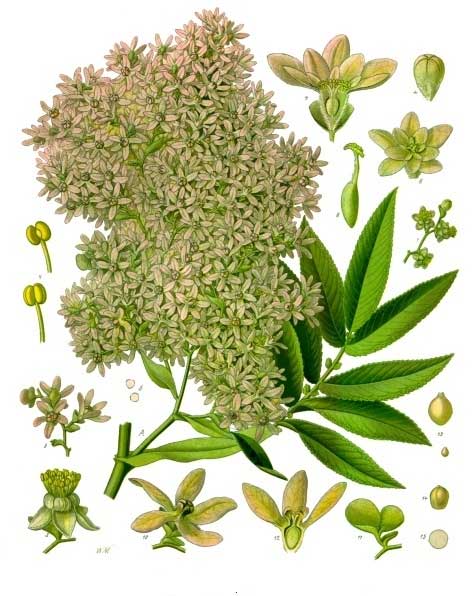
Hagenia abyssinica
Classification System: APG IV
Superregnum: Eukaryota
Regnum: Plantae
Cladus: Angiosperms
Cladus: Eudicots
Cladus: Core eudicots
Cladus: Rosids
Cladus: Eurosids I
Ordoo: Rosales
Familia: Rosaceae
Subfamilia: Rosoideae
Tribus: Agrimonieae
Subtribus: Agrimoniinae
Genus: Hagenia
Species: Hagenia abyssinica
Name
Hagenia abyssinica (Bruce) J.F.Gmel., Syst. Nat. ed. 13[bis]: 613 (1791).
References
Links
Hassler, M. 2020. Hagenia abyssinica. World Plants: Synonymic Checklists of the Vascular Plants of the World In: Roskovh, Y., Abucay, L., Orrell, T., Nicolson, D., Bailly, N., Kirk, P., Bourgoin, T., DeWalt, R.E., Decock, W., De Wever, A., Nieukerken, E. van, Zarucchi, J. & Penev, L., eds. 2020. Species 2000 & ITIS Catalogue of Life. Published on the internet. Accessed: 2020 May 29. Reference page.
Govaerts, R. et al. 2020. Hagenia abyssinica in Kew Science Plants of the World online. The Board of Trustees of the Royal Botanic Gardens, Kew. Published on the internet. Accessed: 2020 May 29. Reference page.
International Plant Names Index. 2020. Hagenia abyssinica. Published online. Accessed: 29 May 2020.
Vernacular names
Deutsch: Kosobaum
Ελληνικά : Αγενία η αβησσυνιακή
suomi: Kosso
Hagenia is a monotypic genus of flowering plant with the sole species Hagenia abyssinica, native to the high-elevation Afromontane regions of central and eastern Africa. It also has a disjunct distribution in the high mountains of East Africa from Sudan and Ethiopia in the north, through Kenya, Uganda, Rwanda, Burundi, Democratic Republic of Congo, and Tanzania, to Malawi and Zambia in the south. A member of the rose family, its closest relative is the Afromontane genus Leucosidea.
Nomenclature
It is known in English as African redwood, East African rosewood,[1] brayera, cusso, hagenia, or kousso, in Amharic as kosso, and in Swahili as mdobore or mlozilozi. Synonyms of the species include Banksia abyssinica, Brayera anthelmintica, Hagenia abyssinica var. viridifolia and Hagenia anthelmintica.
Description
It is a tree up to 20 m in height, with a short trunk, thick branches, and thick, peeling bark. The leaves are up to 40 cm long, compound with 7-13 leaflets, each leaflet about 10 cm long with a finely serrated margin, green above, silvery-haired below. The flowers are white to orange-buff or pinkish-red, produced in panicles 30–60 cm long.
Distribution
It is generally found from 2000–3000 m elevation, in areas receiving 1000–1500 mm of rainfall annually. It can be found growing in mixed afromontane forest with Podocarpus, Afrocarpus, and other trees, and in drier afromontane forests and woodlands where Hagenia is dominant, or in mixed stands of Hagenia and Juniperus procera. It is often found near the upper limit of forest growth, giving way to giant heather zones above it.
Ecology
Hagenia is used as a food plant by the larvae of some Lepidoptera species including turnip moth.
References
Bruijnzeel, L.A.; F. N. Scatena; L. S. Hamilton (2010). Tropical Montane Cloud Forests: Science for Conservation and Management. Cambridge: Cambridge University Press. p. 137. ISBN 9780521760355.
External links
Hagenia abyssinica at the AgroForestry Tree Database (World Agroforestry Centre)
"The Kosso Tree" is a watercolor by William Simpson from 1868
Dressler, S.; Schmidt, M. & Zizka, G. (2014). "Hagenia". African plants – a Photo Guide. Frankfurt/Main: Forschungsinstitut Senckenberg.
Retrieved from "http://en.wikipedia.org/"
All text is available under the terms of the GNU Free Documentation License

